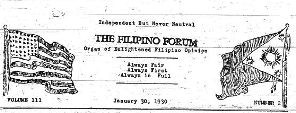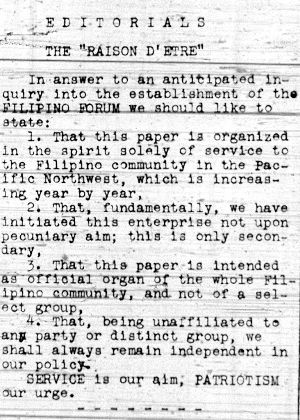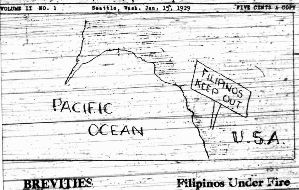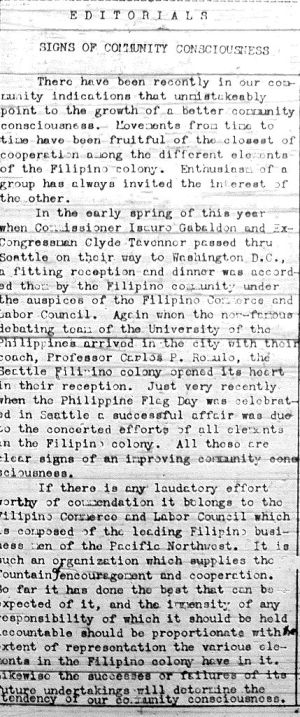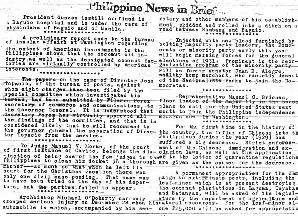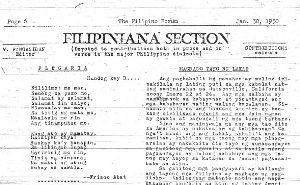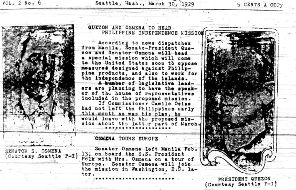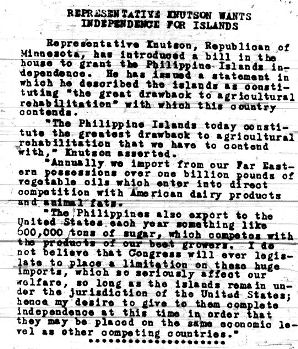Abstract: The Filipino Forum was a bi-weekly newspaper published in Seattle from 1928 to 1969 and edited throughout that time by Victorio Velasco. Billed as the “Independent Organ of Filipinos in the Pacific Northwest,” the newspaper presented articles and stories relevant to the growing Filipino community in Seattle and surrounding areas. This report focuses on the founding years, 1928-1930. Early issues of the newspaper dealt with topics ranging from nationalism, the Philippines’ struggle for independence from American rule, the prejudices experienced by Filipinos in the United States as well as in their homeland, to labor unionism. The Forum also published news from the Philippines (“Philippine News in Brief”), from Filipinos from around the Puget Sound and United States (“Bremerton News,” “Here and There,” “News from Minnesota,” and “News from Pullman”), as well as local society news, Filipino poetry in English and Filipino (“Filipiniana”), wit and humor, and good number of advertisements.
Dates Published: October 15, 1928 to August 15, 1969; published bi-weekly; 6-12 pages; 5 cents per copy; $1.00 for one year subscription in the United States, Philippines, Hawaii, and Alaska; $2.00 for one year subscription in foreign countries.
Editors Cited: Victorio A. Velasco- Editor-in-Chief and Publisher; Emetrio C. Cruz- Associate Editor; M.A. Aquino- Managing Editor; Frederico Plurad-Advertising Manager; V. Panganiban- Filipiniana section Editor
Business Address: 508 King St. Seattle, Washington
Location of Research Collection: University of Washington, Suzallo Library, Microforms and Newspaper Collection, A4137.
Status of Collection: Incomplete; Volume II, No. 13-20 (July 1929- November 1929). No volumes after July 1930 available until November 1943.
Report:
_What is the right to free speech? It is not the right of stating in public that there milestones on the Dover Road; it is the right of speaking controversially. It is the right of controversy.1_
_I believe in the greatest possible freedom of speech, press and assembly, not as an agency of radicalism, but as a social safety measure.2_
As the “mouthpiece of enlightened Filipino opinion,”3The Filipino Forum covered and published issues of importance to the booming Filipino population not only in Seattle but also around Puget Sound and other parts of the United States. First published in October 1928, the paper featured articles dealing with the ongoing fight for independence in the Philippines, the colonial governance of the United States (by far the most debated issue of the time), nationalism, cultural pride, and Filipinos’ experience with racial prejudice. In their “raison d’etre,” the paper declared it was not affiliated with any party or particular group in order to always remain independent in their policy. Many of the articles focused on events in the universities in Washington State (University of Washington, Washington State Normal College in Pullman and Bellingham), across the United States (University of Minnesota), as well in the Philippines (University of the Philippines and University of Santo Tomas). The paper also contained society news, poetry, and wit and humor columns. Some articles and poetry were published in Tagalog, the official language in the Philippines. The Forum also aimed to be a link for all Filipinos in the Pacific Northwest as well being thecommunity’s conscience, providing sharp criticism of their follies and encouraging them to be role models for new Filipino immigrants and act as resident-commissioner ex-officio to Americans.
The Philippine Struggle for Independence
_Grant us our freedom and independence, the freedom, which America promised, and the independence, which we covet. Grant it immediately. Do not delay.4_
When The Filipino Forum began publication, the Philippines had been a US possession for about 30 years and the ongoing debate over granting the colony its independence was at its highest. The newspaper decidedly supported the end of colonial rule and published numerous articles calling for independence. The newspaper featured many articles that dealt with the various efforts of the occupation government to achieve this end. In the December 15, 1928 issue of the Forum, for example, the newspaper ran a headline entitled, “Quezon’s Xmas Gift.” Manuel L. Quezon was the Philippine Senate President at the time of American rule and at the time of the article was bedridden because of a serious illness. The article reported that Quezon was willing to fly to the Washington, D.C. to meet US President Herbert Hoover as soon as possible, despite his poor health and continue negotiations for Philippine independence. The Forum suggested the only gift that Quezon and the Filipino people could afford was a “nice package labeled ‘Plea for Philippine Independence.’” Furthermore, the paper maintained that though the present was small, it was full of sincerity and gravity and was perennially given to the United States government with fervent hope of finally receiving this ultimately longed-for wish.5
In a March 30, 1929 issue, the newspaper ran another article detailing the plan of Philippine Senate President Manuel L. Quezon and Senator Sergio Osmena to head another special mission to the United States to work for the independence of the country and voice their opposition to “measures designed against Philippine products.”6 A year later the newspaper published an Independence Resolution proposed by Resident Commissioner Pedro Guevara and adopted by the First Independence Congress on February 22, 1930, to be presented to the Congress of the United States, which stressed “the real wishes and aspirations of the Filipino people.” The Resolution stated that however light the control of a foreign power on a country, this does not guarantee happiness to its people. Also, it declared that, mindful of the different problems faced by an independent Philippines such as national defense, finance and economics, politics, and education, the declaration of independence of the country was the only recourse to meet the unalterable desires of Filipinos. Furthermore, it argued: “The uncertainty of our future political status hampers the economic development of the country.” The country needed to be self-governed in order to develop democratically and shed its political dependence from the United States, and editor’s suggested the Philippines was better prepared to attain full nation-hood and “ready to assume the risks and responsibilities of independence.” Most importantly, “in keeping with American history and traditions,” independence was a logical outcome given the Filipino’s “long struggles for freedom.”7
American Reaction to Philippine Independence
The Filipino Forum also kept the Filipino community updated on the stance of the United States government through its articles. In a perverse way, many representatives of Congress were in favor of granting the archipelago freedom not because of the realization that it was the fitting destiny of a proud people, but the realization that the colonization of the country was beginning to be a drain on the national economy. The United States’ growing dependence on Filipino sugar became a central issue in this debate. Congressman Timberlake, who authored a sugar restriction bill in 1929, contended the only way to remain independent from sugar imports from the colony was through the restriction of Philippine products from the market, because they competed with crops produced by American farmers. However, he stated “as long as the Philippines are retained under the American sovereignty over the repeated appeals of the Filipino people to be free, it will be unfair to punish the Filipinos (for something they are helpless to prevent) by ruining their industries.”8
In a November 30, 1929 issue, the newspaper prominently carried an article on the front page about the apparent support of Minnesota Republican Congressman Knutson for Philippine independence. In a statement, he claimed the islands constituted the largest drawback to the agricultural rehabilitation of the United States. The islands, he continued, exported over one billion pounds of vegetable oils and 600, 000 tons of sugar, which came into competition with the products of American growers. Knutson claimed that Congress would never set a limit on these huge imports as long as the Philippines remained under the jurisdiction of the United States. The colony would continue to have an advantage in the American markets over other competing nations, because its products would not be subject to the same duties.9
The Congressional proponents of independence also considered the importation of Filipino goods to be potentially dangerous for United States’ investments in Cuba, which amounted to more than eight billion dollars in the agricultural sector. Carter Field’s article, entitled “National Greed and the Philippines,” suggested past endeavors of American lawmakers to allow self-government for the Philippines were not for selfish motives whereas the current movement for the country’s freedom was tainted by the desire by the members of both Houses to save the government money.10 Rather than recognize the legitimacy of political independence for the colony, Carter surmised the economics of sugar and coconut oil would finally win Filipinos their independence.
The Filipino Forum editors roundly criticized Congress’ economic reasoning for granting independence. For instance, in a January 15, 1930 editorial, Victorio Velasco wrote that the American people were beginning to favor Philippine independence; a good number of them were representatives in both the House of Congress and Senate. However, if the U.S. were to give the Filipinos self-rule once and for all, it would be done with very different motives from those upon which the Filipinos had based their claim. The granting of independence of the country would have not meant that the American government believed that the Philippines had the fitness for self-government but on the pressure that lawmakers were experiencing from their constituents, namely farmers and investors. The editor of the Forum, not without a sneer of contempt and irony, concluded after years of armed struggle against the Spaniards and diplomatic relations with the United States that: “Sugar is solving the Philippine problem.”11
Filipino American Race Relations
Another pervasive issue in the Filipino Forum was the sometimes-uneasy relations between Filipinos migrants and native-born Americans. This tenuous dynamic was apparent in everyday life and Filipinos were regularly subject to prejudice. Despite Filipinos’ efforts to integrate in the American society, the newspaper lamented, all too often they were still viewed as outsiders. The November 30, 1928 edition carried an article about the failure of the University Filipino Club to purchase a house (that would function as the group’s headquarters) on 12th Avenue in Seattle. After weeks of negotiation, agreeing on particulars, and raising the money to purchase the building with the help of leading businessmen in the Filipino community, on the day of the signing the owner included a new clause, which leveled stiff interest rates in addition to the base rate of the house. The newspaper reported that a prevalent rumors suggested the owner had changed the contract due to community pressure and anti-Filipino sentiment.12
In other articles, the newspaper reported on cases of discrimination at local schools. One article, entitled, “Filipino Student Suffers from Pang of Race Prejudice,” recorded an incident involving five Filipino male students of the Normal School in Bellingham, WA who attended the annual “Freshman Dance.” As one student, Antonio Velasco recalled, the boys had not intended to dance with their fellow white female students. However, encouraged and assured by the school president’s wife that they could do so without fear of recrimination, one of the boys asked a classmate for a dance. His request was met with the “quite harsh words,” and a “no, thank you.” The boys were finally discouraged to ask anyone for a dance afterwards. Recounting the incident, Velasco wrote, “If only I had the divine power to disappear… that moment we found out that an attitude of race prejudice was being entertained by some of the girls.” He continued, “It was really strange to me to know that such a discrimination prevail in that school.” They realized that this might have been a single occurrence, but the reality remains that some people harbored race prejudices against the Filipino race and this just served to prove this suspicion.13
White Supremacy, Filipino Labor, and the Unions
Throughout the late 1920s, the newspaper covered the tensions between a growing number of young male Filipino migrants to the Pacific Northwest, their white coworkers, and employers. A good number of articles in The Filipino Forum dealt with the backlash experienced by these laborers not only from employers but from labor unions as well. An article in the January 15, 1929 issue, reported that the legislative council of the Seattle Central Labor Council was conducting a study to examine the assertion that Filipinos were swarming into the Northwest and crowding out white labor from the agricultural, lumber, and maritime fields. This particular claim had been brought by a letter from W.J. Henry, a former member and veteran organizer of the American Federation of Labor. In the letter, Henry argued the San Joaquin Valley was now home to 70, 000 Filipinos and the Yakima Valley was being overrun by Filipinos as well. Filipinos, he wrote, posed “a narcotic menace and were … not an elevating influence on our young people. Many of them are marrying white women.” He called upon labor to be vigilant in watching over the “intruders” and not let them take white laborers’ place in the industries. In the same article, the newspaper reported that a recent meeting of the labor council, had suggested that legislation barring or limiting the entry of Filipinos may be sought, and such a movement would be determined largely on the findings of the council’s legislative committee…14
The Forum responded forcefully to such calls. A January 15, 1929 editorial asserted that Filipinos should be guaranteed the same rights as other American citizens, given their history as a colony. Filipinos, being under the American flag, were right to have access to the same privileges accorded to people under American rule. If some wanted to take away these privileges, the editors quipped, the American flag ought to be taken down from the Philippine islands as well.15
The Filipino Forum, though not officially affiliated with any labor organization or political party, endorsed the establishment of the Filipino Laborer’s Association (FLA) in the Editorial section of the newspaper dated May 15, 1930. The newly formed organization would fulfill a much needed role, the article argued, as the representative of working class Filipinos in Seattle and the Northwest. In addition to representing workers, the effect of the organization would spread more broadly as well. The editorial argued, the FLA would also “ create an organ by which the standard of Filipino labor could be regulated; to formulate plans which will enable every Filipino laborer to earn decent wages; and to solve the unemployment problem.” The paper called upon the whole Filipino community to support the work of the FLA and for all Filipino workers, regardless of creed, affiliation, and party alliances to join the organization.
The newspaper’s support for the FLA was also bolstered by their belief that the American Federation of Labor, the strongest representative of workers at the time, had abandoned Filipinos. In their opinion, the AFL did not recognize the concerns of Filipinos workers, discriminated against them, and even bred an environment of hatred and discrimination. As one editor suggested:
The American Federation of Labor has always maintained racial discrimination against Filipino labor and has been hindering our business enterprises. Thru their initiative and endorsement, we find ourselves demoralized and faces a national problem – a race problem of hatred and discrimination.
The FLA, the Forum believed, could raise the standard of Filipino labor. The paper was of the opinion that Filipinos would never get the same treatment as white laborers and the experiences of the Chinese and Japanese were now the realities of the Filipino laborers. The formation of the FLA was a significant step in the continuing progress and prestige of Filipinos in the United States.16
Conclusion
Truthful to its billing as the “organ for enlightened Filipino opinion,” The Filipino Forum served the ever-growing community in the Pacific Northwest from 1928 to 1969. Providing the most pertinent news to its readers, the paper’s coverage and editorials during the first half of the century provided a prism through which Filipinos could view a variety of topics, from Philippine independence to experiences of prejudice (whether in the workplace or in their everyday lives) and commanded their audience to become politically active. It educated Filipinos that they deserved an equal place in the American society. This was the Forum’s very success; it had a hand in forming a critical and “enlightened” community. Moreover, it provided news from around the United States as well as from the Philippines, which connected otherwise discrete Filipino communities around the world. By providing general and local (society) news, the Forum became a “home” where people could keep abreast with what was happening to Filipinos in the US and Philippines.
© Copyright Mark Mabanag 2005
HSTAA 353 Spring 2005
Additional information:
Michael S. Brown, “Victorio Acosta Velasco: Asian American Activist” (Ph.D. dissertation, Washington State University, 2003)
1 Quote from George Bernard Shaw reprinted in The Filipino Forum. October 15, 1928.
2 Quote from Dr. Glen Frank reprinted in The Filipino Forum. January 15, 1930.
3 “Our Program.” The Filipino Forum, January 15, 1929.
4 Quote from Resident Commissioner to the United States of America Camilo Osias addressing the US House of Representative, printed in The Filipino Forum, Jan. 15, 1930.
5 “Quezon’s Xmas Gift,” The Filipino Forum, sec. 1, Dec. 15, 1928.
6 “Quezon and Osmena To Head Philippine Independence Mission,” The Filipino Forum, sec. 1, March 30, 1929.
7 “Commissioner Guevara Introduces Independence Resolution in the House of Representatives,” The Filipino Forum, sec. 1, April 15, 1930.
8 “Timberlake ‘About Ready’ to Support Independence,” The Filipino Forum, sec. 1, May 30, 1929.
9 “Representative Knutson Wants Independence for Islands,” The Filipino Forum, sec. 1, November 30, 1929.
10 “National Greed and the Philippines,” reprinted in The Filipino Forum, sec. 1, Jan. 30, 1930.
11 “Sugar and Independence,” The Filipino Forum, Jan. 15, 1930.
12 “Clubhouse Movement Fails,” The Filipino Forum, Nov. 30, 1928.
13 “Filipino Student Suffers from Pang of Race Prejudice,” The Filipino Forum, Nov. 15, 1928.
14 “Filipinos Under Attack,” The Filipino Forum, Jan. 15, 1929.
15 “Excluding Filipinos in the United States,” The Filipino Forum, Jan. 15, 1929.
16 “The Filipino Laborer’s Association,” The Filipino Forum, May 15, 1930.

